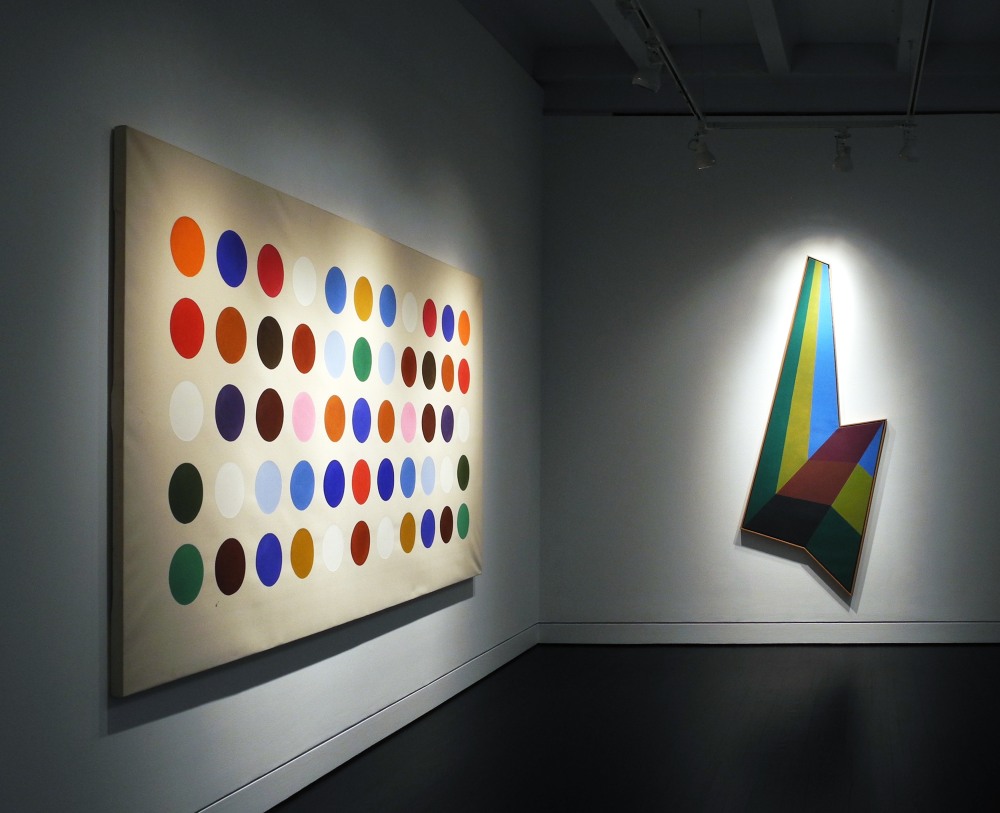
The Washington Color School is back in session. There have been any number of attempts by D.C. museums and galleries to revive the salad days of the 1960s. Local nostalgia-fests culminated in ColorField.remix, a city-wide spectacle led by the Kreeger Museum and joined by the National Gallery of Art, the Phillips Collection, the Hirshhorn Museum and Sculpture Garden, and a suite of local galleries.
That was 10 years ago. In the decade since ColorField.remix, many of the galleries that played host to the festival have shut their doors. Yet the regional style that put D.C. on the map 50 years ago has never been more popular, thanks now to market demand in New York and Los Angeles and on the art-fair circuit.
Downing, Mehring, Reed and Early Alma Thomas, both on view at Hemphill Fine Arts, highlight some of the lesser lights of the Color School. That’s no knock on them. The first three painters—Thomas Downing, Howard Mehring, and Paul Reed—comprised half of the artists in the seminal 1965 exhibit at the Washington Gallery of Modern Art. Gene Davis, Kenneth Noland, and Morris Louis, the other artists whose work traveled with Washington Color Painters, have always enjoyed greater fanfare from curators and collectors. Thomas, an African-American woman whose popular works hew more closely to Henri Matisse than Helen Frankenthaler, has never received a fraction of her due.
Tastes change, though, and so has the art world’s fascination with the Color School. Collectors are waking up to the work of Thomas, Anne Truitt, Sam Gilliam, and other artists who orbited that original nucleus of Color School painters. And within that set, Downing and Reed now stand out for their experiments with shaped canvases, while Mehring’s paintings look as contemporary as they come.
Downing’s “Folding Two” (1968) an accordion-shaped, hard-edged geometric abstraction, strains the eye. Burgundy and cornflower-blue panes at the left edge of the work interact so violently, pulling and pushing one another, that the painting looks like a tesseract that might collapse in on itself. Downing’s “Grid 1 Series, April 21, 1971,” an 11-foot-long dot painting, anticipates the first of Damien Hirst’s celebrated “spot” paintings by about 15 years.
Paintings in Downing, Mehring, Reed don’t much emphasize the staining method that earned such acclaim for the Color School (and Frankenthaler, the artist who inspired D.C.). Hemphill is showing the hard-edged stuff, including Reed’s “Hackensacke” (1967), a knock-out painting that takes the shape of a lopsided chevron. Reed’s more familiar “disk” paintings—a diagonal band of color inset with a circle—are represented by “#3” (1965). These paintings never quite amounted to a rigorous, sustained color study like Josef Albers’ “Homage to the Square” series. But “Upstart ‘A’” (1966), a sharp zig-zag painting by Reed, looks fresh and invigorating by any standard.
Mehring deserves the biggest re-think of all. His paintings aren’t as ubiquitous in permanent holdings as the rest; his works at Hemphill, muted but unyielding all-over abstractions, may make a first impression even on Color School admirers. Mehring’s dappled-eggshell “Untitled” (1961) and mottled-blue “Untitled” (1960–61) would fit any art-fair showing of so-called “zombie formalism,” the derisive term for contemporary paintings that, well, look like Mehrings and sell like hotcakes. It’s not Mehring’s fault that painters have exhausted concepts for which he was never given enough credit for discovering in the first place.
This marketplace zeal for structured, formalist abstraction is partly responsible for the recent resuscitation of Gilliam’s career. If there’s any justice in the universe, Thomas is next. She enjoyed a blockbuster solo exhibition at the Studio Museum in Harlem last fall, a refreshing revisit on an otherwise under-regarded career.
Early Alma Thomas offers a peek at the artist’s work before she turned to petal-shaped brushstrokes that borrowed from Matisse’s cut-outs. “Milky Way” (1959) and “Reflections” (1960) show the trajectory that she might have otherwise followed. During a brief window, Thomas was looking in the same direction as Joan Mitchell, the painter who is enjoying perhaps the strongest resurgence of any mid-century abstract expressionist. “Still Life with Bottles” (1955) helps to demonstrate how quickly Thomas’ painting evolved from loose abstraction to pure formalism.
Thomas earned the spotlight in 2009 when Michelle Obama picked one of her paintings, “Watusi (Hard Edge)” (1963), to hang in her East Wing office. The painting didn’t fit the space, so it was returned to the Hirshhorn collection (where it is best remembered for being a rip-off of a 1953 painting by Matisse). With the Obama boost and her Studio Museum solo, Thomas is well-positioned for a posthumous revival. Whether she will get the same reconsideration as her peers is a question for the markets—and the markets are fickle.